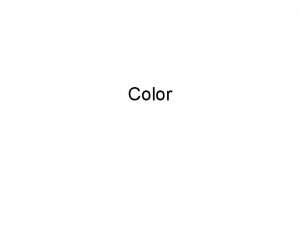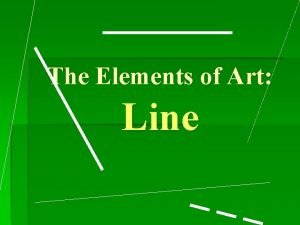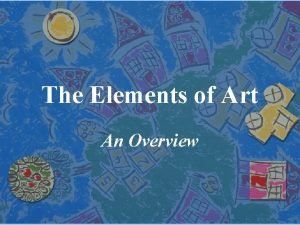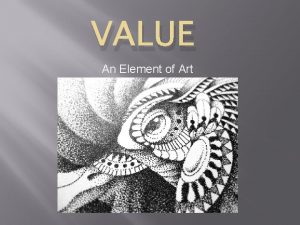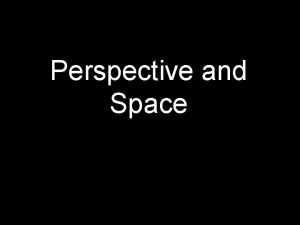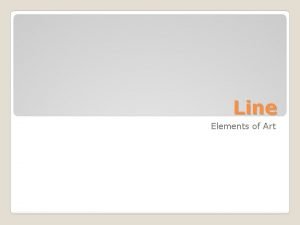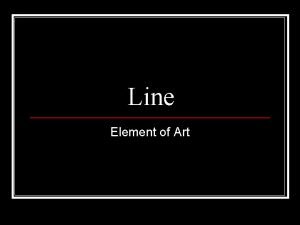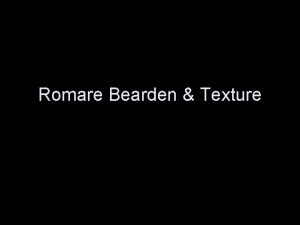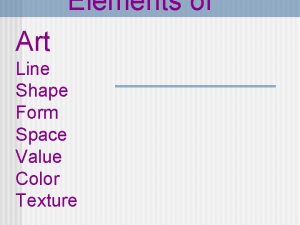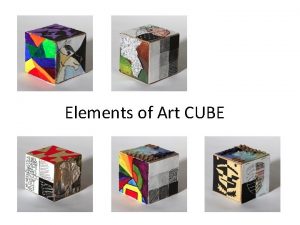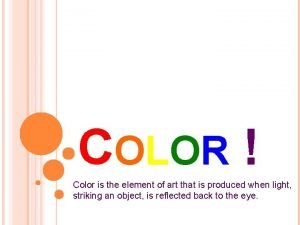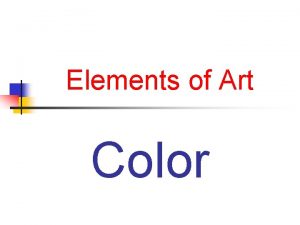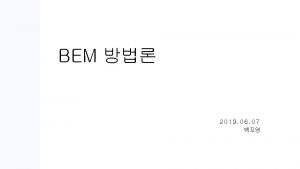Element of Art Color WHAT IS COLOR Color














- Slides: 14

Element of Art Color

WHAT IS COLOR? Color is the element of art that is produced when light strikes an object and is reflected back to the eye. It has three main characteristics: hue, value and intensity Hue: the name of the color (ex. Red, purple, magenta, etc. ) Value: describes lightness or darkness of a color (review “value” element- same stuff applies only now we’re adding color into the mix) ex; pink vs. smoky-burgundyred. Intensity: describes the saturation of a color (can also describe the amount of pigment a color has in it) Low intensity = pastel colors/low pigment content High intensity = very bright and vibrant/high pigment content

Red Yellow-Green Turquoise Green HUE- THE NAME OF A COLOR Blue-Purple Magenta

VALUE- DESCRIBES LIGHTNESS AND DARKNESS OF A COLOR Tone Scale Light………. . ……………………… Gradient Scale Light………. . ………………………

INTENSITY- SATURATION LEVEL OF A COLOR Dull, Pastel Bright, Vivid

The color wheel: A chart showing color relationships A Color Schema- a grouping of colors. Primary- Red, Blue, and Yellow. The elemental building blocks of color; with these three colors you can make any other color. Secondary- Orange, Green, Violet. The colors made by mixing equal parts of 2 primary colors. Tertiary- The colors made by mixing equal parts of 1 primary and 1 secondary color. Formula for naming Primary tertiary colors: primary-secondary Ex: red-orange, blue-green, yellow- Tertiary Primary Secondary Primary Tertiary Secondary

OTHER COLOR RELATIONSHIPS COMMON WAYS COLORS CAN RELATE TO EACH OTHER Analogous: Next-door neighbors on the color wheel Monochromatic: Mono= one Chromatic= color Complementary: opposites on the color wheel Neutral: mix all primary colors together Warm: more Red

MONOCHROMATIC SAME COLOR- ADD WHITE OR BLACK TO GET HIGHLIGHTS AND SHADOWS.

ANALOGOUSSIMILAR COLORS, COLORS FROM THE SAME FAMILY

COMPLEMENTARYCOLORS THAT ARE OPPOSITES ON THE COLOR WHEEL

NEUTRAL COLORS THAT HAVE ALL THREE PRIMARY COLORS PRESENT Black and white are also concentered

WARM VS. COOL General Rule: Warm Color has more red than blue Cool Color has more blue than red

1 2 3 4 5 6

 It is the most expressive elements of art
It is the most expressive elements of art Distinguish between a signal element and a data element.
Distinguish between a signal element and a data element. Signal element vs data element
Signal element vs data element Line element of art
Line element of art Elements of art: color
Elements of art: color 5 basic elements of art
5 basic elements of art Value art element
Value art element Space element of art
Space element of art Sharp, jagged, graceful, smooth
Sharp, jagged, graceful, smooth Line element art
Line element art An element of art that is derived from reflected light
An element of art that is derived from reflected light Romare bearden three folk musicians
Romare bearden three folk musicians What are the building blocks of art
What are the building blocks of art Line shape space
Line shape space Element of art cube
Element of art cube
